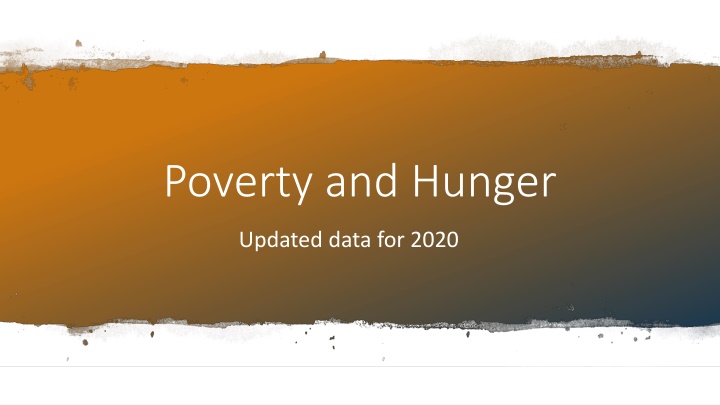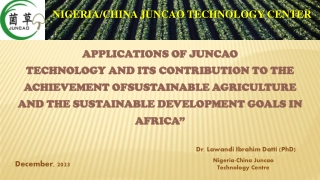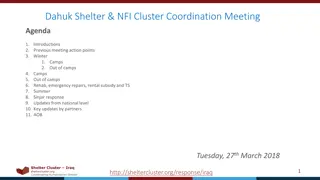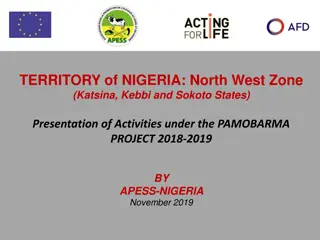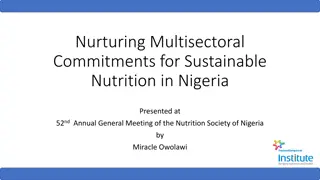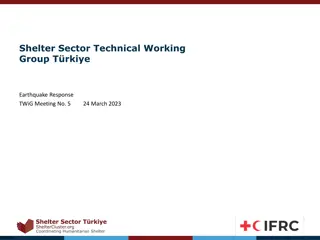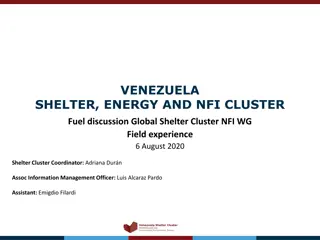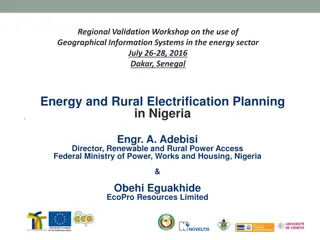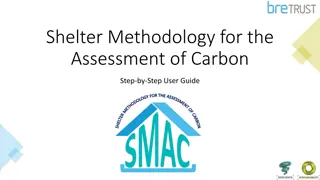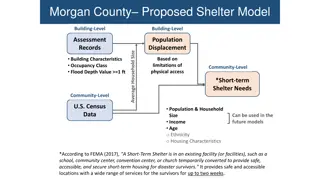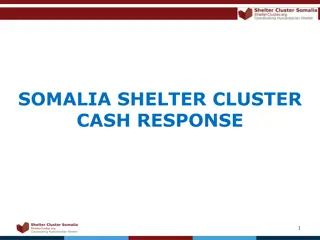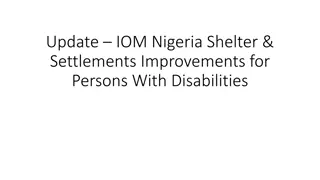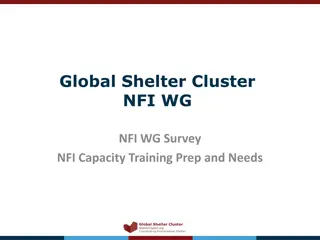Shelter and NFI Sector Strategy in Nigeria
Providing guidance on harmonizing shelter and NFI sector strategies in Nigeria to enhance predictability and equitable response, with a focus on delivering emergency shelter solutions to displaced populations. Objectives include targeted delivery of shelter kits, upgrade of camps, and provision of appropriate solutions for vulnerable IDPs.
Download Presentation

Please find below an Image/Link to download the presentation.
The content on the website is provided AS IS for your information and personal use only. It may not be sold, licensed, or shared on other websites without obtaining consent from the author.If you encounter any issues during the download, it is possible that the publisher has removed the file from their server.
You are allowed to download the files provided on this website for personal or commercial use, subject to the condition that they are used lawfully. All files are the property of their respective owners.
The content on the website is provided AS IS for your information and personal use only. It may not be sold, licensed, or shared on other websites without obtaining consent from the author.
E N D
Presentation Transcript
Poverty and Hunger Updated data for 2020
How to Use Please use this presentation for your own information or to help prepare for presentations, develop newsletter content or otherwise to raise awareness about hunger within your congregation. This data was analyzed for this presentation in November 2020. Please do not repost this presentation on personal or congregational websites or otherwise online. If you have questions, please contact Ryan Cumming at Ryan.Cumming@elca.org.
Sources USDA, State of Food Security domestic hunger Census Bureau domestic poverty FAO global food security World Bank global poverty Current Population Survey American Community Survey
Domestic US Poverty and Income
1 person (average):$13,011 1, under 65: 1, 65 or older: $13,300 $12,261 U.S. POVERTY THRESHOLDS- 2019 2 people: $16,521 3 people: $20,335 4 people: $26,172
U.S. OFFICIAL POVERTY - 2019 10.5% of Americans were living in poverty in 2019 (down from 11.8% in 2018) 34.0 million people, (down from 38.2 million in 2018) 14.4% of children were living in poverty in 2019 (down from 16.2% in 2018) 10.5 million children, down from 11.9 million in 2018
Poverty by Race, 2019 Non-Hispanic White Poverty Rate: 7.3% Count: 14.2M Decline, 2018-2019: 0.8% Black Poverty Rate: 18.8% Count: 8.1M Decline, 2018-2019: 2.0% Hispanic Poverty Rate: 15.7% Count: 9.5M Decline, 2018-2019: 1.8%
Domestic US Food Security
U.S. FOOD SECURITY - 2019 Food insecure lacked access to enough food for an active, healthy life for all household members Recurrent not chronic 10.5% of households were food insecure at least some time during 2019 (decrease from 11.1% in 2018) 10.9% of individuals 35.2 million were in food-insecure households (down from 37.2M in 2018) 4.1% had very low food security (disruption in eating patterns) (2018 4.3%) 11.845 million people had very low food security
Child Food Security - 2018 Very tricky to measure Often, only adults are food-insecure Not all children are food-insecure Children were food-insecure in 6.5% of households (down, but not significantly, from 7.1% in 2018 lowest level since 1998) 5.332M children, or 7.3% of children (2018 6M) Both children and adults experienced very low food security in 0.6% of households children were hungry, skipped a meal, or did not eat for a whole day 361,000 children, or 0.5% (560,000 or 0.7% in 2018)
Global Poverty and Income
Global Poverty by the Numbers Global extreme poverty threshold = $1.90/day 9.2% in 2017 (most recent year) down from 10% in 2015 689 million people in 2017 (down from 741 million in 2015 and 1.9bn in 1990)
Global Hunger
Prevalence of Undernourishment - Global The worrisome trend in undernourishment continues 653.2 million in 2017 8.7% 678.1 million in 2018 8.9% 687.8 million in 2019 8.9%
Drivers of Poverty and Hunger Conflict Burundi, Central African Republic, Democratic Republic of the Congo, Libya, Mali, Nigeria, South Sudan Climate Events Drought Madagascar, South Africa, Zambia, Zimbabwe Flooding Could contribute to 68-132 million people in poverty by 2030 Increased debt Trade policies Lack of access to healthcare and education Poverty (only about 50% of hunger)
COVID-19 Impact Global
It is important to recognize that any assessment at this stage is subject to a high degree of uncertainty and should be interpreted with caution (FAO, SOFI) These findings must be considered with utmost caution (WFP)
Food Production Food Utilization -limited labor mobility -plant closures -limited production of fruits, vegetables, dairy -shift to shelf-stable foods -shift toward grain -trade barriers COVID COVID- -19 and 19 and Hunger Hunger Food Access Social Protection -formal/informal market closures -limited consumer mobility -supply chain bottlenecks -reduced purchasing power -price increases -Closure of feeding sites -Non-existent or overwhelmed safety nets -Cancellation of healthcare and nutrition home- or village- based programs
Economic Impacts of COVID Estimate of 4.4% contraction of global GDP Some Notable Drivers Lost income informal workers lost ~60% of earnings in month after pandemic was declared (informal workers in Africa and Latin America lost 80%) only 27 countries Remittances Currently 800 million recipients in 125 countries Expected to decrease by 20% by end of 2020 Women may be hardest hit Overrepresented in frontline health sector and household care Increased risk of domestic violence WFP This analysis suggests that, for many poor countries, the economic consequences will be more devastating than the disease itself
Poverty Outlook Current number of people in extreme poverty = 689 million Baseline - 5% contraction increase of 88 million people by end of 2020 Downside - 8% contraction increase of 115 million people by end of 2020
Estimated Projections for Hunger 265 million WFP Global Food Crisis Report Announced in April as doubling number of hungry Crisis-level hunger IPC/CH Phase 3 or higher Based on numbers in Phase 2 (stressed) THIS 83-132 million FAO Based on three scenarios, using different projections for GDP growth and contraction Increase in number of undernourished people facing hunger COULD BECOME THIS
Hunger is estimated to increase by 83-132 million people by the end of 2020 COVID will push 100 million people into extreme poverty by the end of 2020. The most conservative estimates are that global hunger and extreme poverty will both increase by 12%. There is not a single root cause of hunger that is not worsened by the pandemic and responses to the pandemic. Messages on COVID - Global
COVID-19 Impact Domestic
Domestic Income and Poverty Projections
Domestic Income and Earnings *current reporting
Estimates suggest that domestic hunger has already doubled or tripled in 2020 (from 10.5% to as much as 38%). More than a quarter (27%) of adults in the US are economically insecure. The social safety net has been working kind of. Messages on COVID - Domestic
